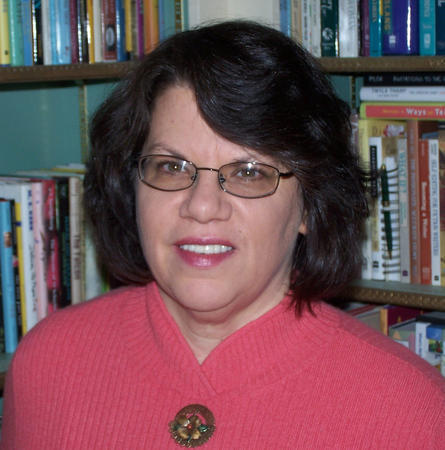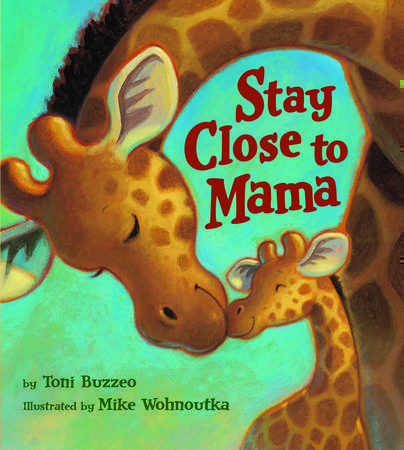 Toni Buzzeo is the author of several picture books for children, including “Stay Close to Mama.” Below is a complete transcript of her interview with Cracking the Cover.
Toni Buzzeo is the author of several picture books for children, including “Stay Close to Mama.” Below is a complete transcript of her interview with Cracking the Cover.
Have you always wanted to be a writer?
If “always” stretches back to early childhood, then my answer would be no, because when I was a child, I didn’t even know a person could grow up to be a writer. When I was young, I never met an author, so despite being a passionate reader, it never occurred to me that there was such a career. However, by the time I was in junior high and had started writing lots of poetry, I definitely identified myself as a writer. Still, I didn’t know I could pursue it as my career and so opted to become a teacher and eventually a school librarian.
Why do you write for young people?
I write for children because I am passionate about children’s literature, having been a classroom educator and then a school librarian for so many years. Just as importantly, though, I love children and consider them, wherever they may be, to be the most important people on our planet.
Where do the ideas come from?
Children often ask me that very question in my many school and library author visits. The answer is that I generally see (on television, in a movie, or in daily life), hear (on the radio or from someone I know), or read something that piques my interest. I go in search of more information and if that idea resonate emotionally for me and connects to my own experience in some way, I’ll go forward to play with it in writing.
 Where specifically did the idea for “Stay Close to Mama” come from?
Where specifically did the idea for “Stay Close to Mama” come from?
In 1995, I went on a safari in Kenya, Africa with my husband Ken and my son Topher. There, I fell in love with the beautiful giraffes of the savannah. Then, during the second week of the trip, we visited Lewa Wildlife Conservancy where I encountered the story of a small giraffe who had wandered away from his mother and fallen into the swimming pool near the house. Residents had to rescue the poor little giraffe. And that so sparked my imagination that I came home and wrote it—my very first story for children. Of course, it was a different story from the Stay Close to Mama book you have read, as it underwent years of rethinking and revision before it was published this spring.
Do you work on more than one story at once?
I don’t necessarily actively work on more than one story at a time, but yes, I do always have several unfinished manuscripts or manuscripts under revision at the same time. What I firmly believe is that even when I am not currently adding to or revising a manuscript, my subconscious is busy with it and that when I return to the page, I’ll have more information and more ideas that will make the work proceed more quickly.
You’ve been pretty prolific. Do you ever find yourself referring to your previous work?
I have been prolific, it’s true, especially when you consider the 20+ manuscripts that I have underway that haven’t yet sold to publishers. Over the years, I’ve learned so much about how picture books work. I’ve thought a lot about structure. I’ve learned about pacing and the necessity of rising tension, even in humorous picture books. So yes, there are times when I remember that not only can I be helped by looking at the fine work of my colleagues—other picture book authors—but also by looking back at my own work and the ways that I employed those skills I have learned.
Of course, when writing sequels (such as Adventure Annie Goes to Kindergarten which followed Adventure Annie Goes to Work) or companion books (such as Just Like My Papa, a companion book to Stay Close to Mama which will be published next spring 2013), it is essential that I check back in on my previous work to ensure that there is consistency in structure, characterization, and setting.
 Do you have a say in the illustrations?
Do you have a say in the illustrations?
Oh yes, very much so. Not only do my editors confer with me about prospective illustrators, but they also ensure that I have the opportunity to give feedback on the first round of sketches and the second round of revised sketches once an illustrator is contracted.
That said, isn’t Mike Wohnoutka’s illustration style just a perfect accompaniment to the story in Stay Close to Mama? I love the warmth he portrays in the relationship between Mama and Twiga and his brilliance in adding a morning-to-night time frame to the sequence of events in the story. I feel so fortunate to be working with Mike on the companion book, Just Like My Papa (Hyperion, spring 2013).
Why do you think “Stay Close to Mama” will appeal to children?
Every child knows the tension between obeying his or her parents and following his or her own whims or curiosity. While giraffes are known to be exceptionally curious creatures, so are children! And sometimes, even when children don’t mean to be naughty, they simply forget what their parents ask them to do (“No, little Twiga. Stay close, stay safe.”).
Besides, who can resist a giraffe? With their long necks, pointy faces, and patchy coats, they are just about the most adorable animals on the planet.
Take me through your typical day.
I do a great deal of traveling to visit schools across the United States and overseas, but a typical day is one when I am at home in my colonial Maine farmhouse. I read e-mail and drink a cup of tea as soon as I get up, then eat a bowl of Ken’s homemade organic granola with soymilk and home-grown blueberries or raspberries if it is summer. After breakfast, I tackle any business e-mail needing my attention, then head out to exercise in a warm water pool. I return to have lunch and then walk across the lawn to my writing cottage above the stream (check out the video of the cottage being built at http://www.youtube.com/watch?v=xUYXf6jMZPw) for 2-4 hours of uninterrupted fiction writing. Later in the day, I return to my office in the house to work on articles and other freelance writing projects. Evening finds me crocheting, beading, watching a movie, or reading before a very late night lights-out.
How has your writing evolved since you first started?
When I first started to write for children, I was still employed as a school librarian and had a world of children’s literature at my immediate fingertips every weekday. Still, I hadn’t yet mastered the necessity of finding excellent published models for characterization, structure, and plot. My mentor, children’s author Jane Kurtz, slowly taught me to do this. I also didn’t yet have an authorial voice that I could rely on to take hold as I began a new story and stay with me throughout the writing of it. Each manuscript was a new challenge for me as I slowly learned how to impose structure on an idea, how to identify my main character’s problem and intensify that problem as he or she struggled to solve it. Those early years were an exciting time of learning so many of the skills that I now readily put to use each time I set words on paper (or screen).
Do you have a book that resonated with you as a child?
My favorite picture book when I was a child was Duck and His Friends by Katherine and Byron Jackson, illustrated by a very young Richard Scarry. Oh did that book resonate for me, for Duck was afraid to swim, as was I. In fact, I was terrified even to get my face wet at all, which made washing my hair quite a challenge, as you can imagine. I very much liked that Duck shared my problem, that he was timid like me, but that he found friends who helped him to overcome his fears. As a child who lived in a world of adults, without young friends, I was charmed by the idea of friends who could help you with a problem!
What are you working on now?
I’ve been working on a couple of new stories recently, particularly a very young chapter book for those children just getting ready to move beyond easy readers and jump into a slightly longer book. This story, the first in a series, I hope, is about Darwin McDougal, who is a champion Florida sand castle builder forced to move to Maine when his mother enters medical school there, and hopeful that snow castle building will replace his Florida sand castles. Unfortunately, it’s a Maine winter with no snow and Darwin is desperate to change that.
